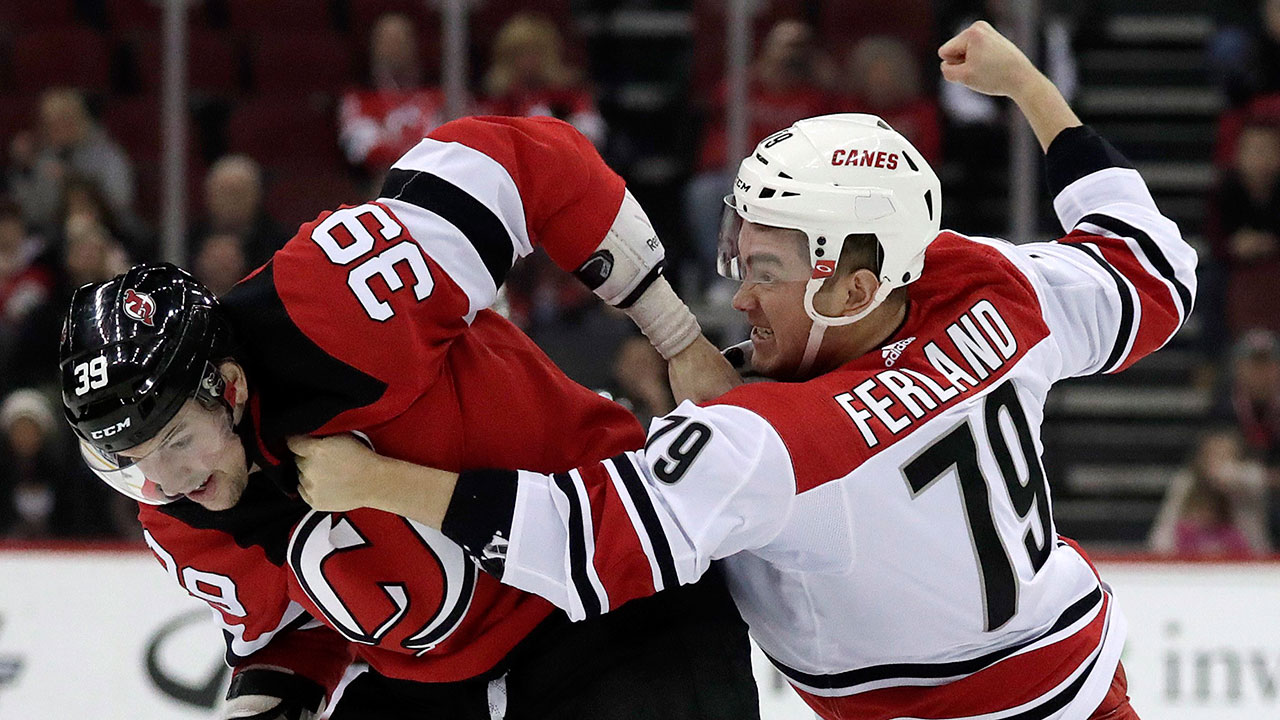VANCOUVER – You may not want Micheal Ferland on your team, but you sure don’t want him on the other one.
The Vancouver Canucks became harder to play against with Wednesday’s free-agent signing of Ferland to a four-year, $14-million contract.
The cannonball winger was a Canuck killer the last time Vancouver made the playoffs when, as a National Hockey League rookie in 2015, Ferland blew up defencemen on the forecheck and scored three times in the Calgary Flames’ six-game, first-round victory.
Ferland revealed then that his mother asked him not to hurt Canuck legends Daniel and Henrik Sedin, but the wrecking ball from Swan River, Man., hurt a lot of other Vancouver players.
He has evolved into a pretty good NHL player since then, averaging 19 goals, 41 points, 176 hits and a 53.15 shots-for percentage in the past two seasons for the Flames and Carolina Hurricanes.
Had Ferland asked for four years at $3.5 million last winter, he’d probably still be with the Hurricanes. But having seen Washington Capitals enforcer Tom Wilson sign a ludicrous six-year, $31-million extension last summer, Ferland priced himself out of Raleigh.
Can’t wait to see @ferdaddy27 in #Canucks colours! pic.twitter.com/miso4LsxS5
— Vancouver Canucks (@Canucks) July 10, 2019
In the end, Hurricanes coach Rod Brind’Amour may not have lobbied too hard to keep Ferland, who comes with warning labels. Most of his production has been generated riding shotgun with top players, he has a concussion history and Ferland has done little in two playoffs since that memorable series against Vancouver.
Canuck fans, who saw their team get alarmingly stale after its run to the 2011 Stanley Cup Final, should know better than most the dangers of sentimentality.
But Ferland is only 27, and he’ll have a chance to play in the top-six with the Canucks while providing some physical protection for Elias Pettersson, Brock Boeser and Quinn Hughes. And his annual salary of $3.5 million – modest inflation on the four-year, $12-million deal the team gave Antoine Roussel last summer – represents a steep discount from what Ferland had been projected to command as an unrestricted free agent.
Of course, free agency opened 10 days ago, and NHL teams are now shopping the bargain racks.
More important than Ferland’s salary is his four-year term, which will overlap the second contracts for Pettersson and Hughes in 2021.
Vancouver general manager Jim Benning also has yet to re-sign Boeser, a restricted free agent ineligible for arbitration or a predatory offer sheet, and that deal for $7-to-8 million annually will put the Canucks over next season’s salary cap of $81.5 million.
Benning had said the league’s recent recapture penalty after Roberto Luongo’s retirement – which will cost the Canucks a net annual increase in salary-cap costs of about $2.2 million for the next three years – might prevent Vancouver from adding another free agent.
The Canucks signed defencemen Tyler Myers, Jordie Benn and Oscar Fantenberg on July 1, a week after acquiring top-six winger J.T. Miller in a trade with the Tampa Bay Lightning.
But wanting more toughness and scoring depth, Benning obviously felt the price for Ferland was one he could afford, even though it increases the strain of Loui Eriksson’s bad contract and will likely force the Canucks to shuffle a couple of veterans to the minors to make room for a Boeser extension.
Depth forward Tim Schaller, a major disappointment last season after Benning signed him as a free agent to two years at $1.9 million, seems destined for the Utica Comets. The Canucks may also send either Fantenberg ($850,000) or Alex Biega ($825,000) to the American Hockey League, rather than carry eight defencemen next fall.
But that savings of about $1.9 million still won’t quite be enough to accommodate Boeser’s next contract. One way or another, Benning will probably have to find an exit for Eriksson, even if that means sending the $36-million man to the minors at age 34. Eriksson is due only $9 million in the final three years of his front-loaded contract, but his $6-million annual cap hit is about to become a kerosene fire for the Canucks.
If Benning could, he’d probably take a poison pill like the Toronto Maple Leafs did two weeks ago when they traded away a first-round draft pick to shed Patrick Marleau’s final season at $6.25 million. But offloading Eriksson likely won’t be that easy.
Sending him to the minors saves the Canucks only $1.075 million because Eriksson would still carry a cap hit of $4.925 million. But as a final option, it would buy Benning some time and may just get Vancouver under the salary cap for the start of the season.
Nothing happens in isolation. It’s naïve to think Benning could sign Ferland without the full backing of owner Francesco Aquilini, who would understand the salary-cap ramifications and be willing to live with them in order to make the Stanley Cup playoffs next April.
And that, obviously, has been the goal for the Canucks since last season ended.
[relatedlinks]










